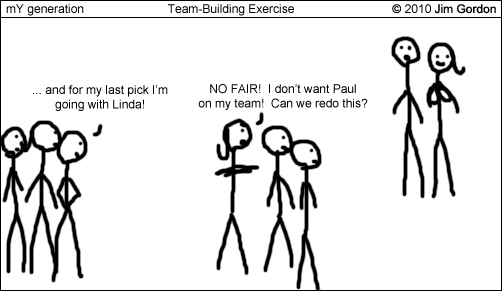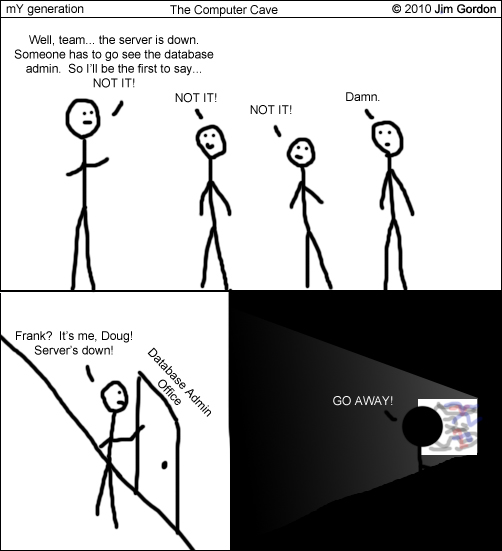|
|
|
Thursday, July 14th, 2011
 “I thought the whole process was more geared toward problem-solving than to me talking about who I was as an applicant and I liked that.” Andrew Snyder, 25 “I thought the whole process was more geared toward problem-solving than to me talking about who I was as an applicant and I liked that.” Andrew Snyder, 25
Hiring is in the top three, if not number one, of actions that ensure success, because it is having the right people that builds the strong teams that juice creativity and make it possible for the company to pivot as needed.
Hiring well means interviewing well and while there are many approaches to hiring there is nothing that can take the place of a really good interviewing process and well-trained interviewers.
Teams are old hat in some industries, but in others they are considered radically innovative and startup Virginia Tech Carilion Medical School is in that category.
The year-old startup, more than three years in the planning, received 2,700 applications for 42 openings in each class.
The applicants were first screened by traditional methods (grades, SAT scores, etc.) and 239 were invited to interview—and that is where things changed.
Driven by research, Carilion decided that (1) excellent communication and (2) strong social skills were must haves for any candidate they accepted.
The first is a growing catalog of studies that pin the blame for an appalling share of preventable deaths (98,000 deaths each year) on poor communication among doctors, patients and nurses that often results because some doctors, while technically competent, are socially inept.
The second and related trend is that medicine is evolving from an individual to a team sport.
Rather than rely on an interview with one recruiter, Carilion utilized a different approach called Multiple Mini Interviews (M.M.I.)
The system grew out of research that found that interviewers rarely change their scores after the first five minutes, that using multiple interviewers removes random bias and that situational interviews rather than personal ones are more likely to reveal character flaws, said Dr. Harold Reiter, a professor at McMaster University in Hamilton, Ontario, who developed the system.
Here’s how it works,
…the school invited candidates to the admissions equivalent of speed-dating: nine brief interviews that forced candidates to show they had the social skills to navigate a health care system in which good communication has become critical.
MMI is used by eight other medical schools including Stanford and UCLA.
It’s a great approach, especially for screening out those who believe their vocation or actions confer god-like status—and the ego to go with it. Those types don’t play well with others and are rarely, if ever, strong team players.
I’ve been a fan of team hiring for years and done correctly the speed interviews bump it to the next level; a far smarter approach than Google’s algorithm or the normal one-on-one, with an introduction to a few team members.
Image credit: Virginia Tech Carilion School of Medicine
Posted in Communication, Entrepreneurs, Hiring | No Comments »
Friday, July 1st, 2011
A Friday series exploring Startups and the people who make them go. Read all If the Shoe Fits posts here

Team and culture are a startup’s bedrock for success, but culture takes priority because it is culture that attracts a great team.
Founders talk constantly about ‘the team’ and those listening, investors, media and employees, assume that “team” refers to all the company’s employees—not just a select few.
However, some founders have two teams, the one about which they talk and the team that exists covertly in their minds.
Mental teams consist of direct reports and pets, who are often close personal friends; public teams encompass everyone.
But it’s the mental team that takes priority and stays front and center in all decisions.
Having two teams is akin to having two sets of books—one reflecting reality, the other for show and tell—and, like a second set of books, mental teams trash cultural touchstones such as transparency, authenticity and trust.
Over the years an entire vocabulary has developed to talk about teams. When it’s used by founders who buy it, own it and mean it that language is enormously empowering; for the others it is pap—good for keeping all those not on the ‘real’ team in line.
One would think that trashing those touchstones would wreak more havoc with younger workers, who are considered more demanding, but in actuality older workers are just as turned off.
The exceptions, of course, being those who don’t see a problem, since they do the same thing.
Option Sanity™ supports transparency
Come visit Option Sanity for an easy-to-understand, simple-to-implement stock process. It’s so easy a CEO can do it.
Warning.
Do not attempt to use Option Sanity™ without a strong commitment to business planning, financial controls, honesty, ethics, and “doing the right thing.” Use only as directed.
Users of Option Sanity may experience sudden increases in team cohesion and worker satisfaction. In cases where team productivity, retention and company success is greater than typical, expect media interest and invitations as keynote speaker.
Image Credit: Bun in a Can
Posted in Entrepreneurs, If the Shoe Fits | No Comments »
Thursday, October 21st, 2010
 True leadership often defies conventional wisdom about what works and what doesn’t in order to succeed. True leadership often defies conventional wisdom about what works and what doesn’t in order to succeed.
Conventional wisdom says that a high school with 4100 students and 300 teachers is doomed to fail, which it did until a giant dose of in-house of initiative and tenacity turned it around.
In 2000 only a quarter of Brockton students passed statewide exams and a third dropped out; compare that to now.
This year and last, Brockton outperformed 90 percent of Massachusetts high schools.
This wasn’t accomplished by a charismatic, visionary leader who came from outside, firing up the troops and getting rid of dead wood.
It came from a group of teachers working under a principal who did nothing.
That team of leaders took the initiative, meeting on their own time to craft an approach that would work.
Then Susan Szachowicz and a handful of fellow teachers decided to take action. They persuaded administrators to let them organize a school wide campaign that involved reading and writing lessons into every class in all subjects, including gym.
An approach that didn’t cost more money, but one that fundamentally changed Brockton’s culture.
Moreover, they had the tenacity to keep selling the concepts to their peers in the face of doubt and resistance. Not just with words, but with support and training.
In just one year test scores rose dramatically.
Overnight, the restructuring committee gained enormous credibility, and scores of once-reluctant teachers wanted to start attending its Saturday meetings, which continue today.
Szachowicz became principal in 2004, replacing the positional leader who did nothing.
Read the article (it includes a link to the Harvard study) and remember it the next time conventional wisdom tries to dictate to you what can and can’t be done.
Image credit: Tombstone image generator
Posted in Leadership's Future | No Comments »
Monday, October 18th, 2010
 The whole world followed the 69 day struggle to rescue the Chilean miners and what they accomplished underground prior to and during the rescue. They are safe now, but their team attitude is just as strong. The whole world followed the 69 day struggle to rescue the Chilean miners and what they accomplished underground prior to and during the rescue. They are safe now, but their team attitude is just as strong.
The daughter of one of them says the men have agreed to share all their earnings from interviews media appearances movies or books. A fellow miner close to many of the men says they’ve hired an accountant to keep track of their income, and to distribute it equally. He says they’re going to be very close to the chest, and “will speak together as a group.”
The media presents it as one leader and 32 followers, but it doesn’t seem that the miners see it that way.
People love to quote the adage “there is no “I” in team” when somebody’s ego gets out of hand; perhaps a new adage is needed that states “there is no “I” in leader.”
Of course, someone will argue that there is an ‘i’ in leadership, which is true, but when ‘i’ becomes ‘I’ it changes leadership to leadershit.
Flickr image credit: Hugo Infante/Government Of Chile
Posted in Leadership | No Comments »
Sunday, July 18th, 2010
See all mY generation posts here.

Posted in mY generation | No Comments »
Tuesday, July 6th, 2010
 This is as true today as it was 38 years ago when Dr Robert McNeish first expounded on it. This is as true today as it was 38 years ago when Dr Robert McNeish first expounded on it.
1. As each bird flaps its wings, it creates an ‘uplift’ for the bird following. By flying in a V formation, the whole flock adds 71% more flying range than if each bird flew alone.
Lesson: People who share a common direction and sense of community can get where they are going quicker and easier when they are traveling on the thrust of one another.
2. Whenever a goose falls out of formation, it suddenly feels the drag and resistance of trying to fly alone and quickly gets back in formation to take advantage of the ‘lifting power’ of the bird immediately in front.
Lesson: If we have as much sense as a goose we will stay in formation with those who are headed where we want to go. (If none are then we know we are with the wrong flock. Ed.)
3. When the lead goose gets tired it rotates back into the formation and another goose flies at the point position.
Lesson: It pays to take turns doing the hard tasks and sharing the leadership interdependent with each other.
4. The geese in formation honk from behind to encourage those up front to keep up their speed.
Lesson: We need to make sure our honking from behind is encouraging, rather than making less helpful noises.
5. When a goose gets sick, wounded or shot down, two geese drop out of formation and follow him down to help and protect him. They stay with him until he is either able to fly or dies. Then they launch out on their own with another formation or to catch up with the flock.
Lesson: If we have as much sense and compassion as the geese, we’ll skip the politics and knives and support each other.
Flickr image credit: http://www.flickr.com/photos/zedbee/103147140/
Posted in Culture, Ducks In A Row, Personal Growth | No Comments »
Monday, June 28th, 2010
 When you evaluate a task or project to you see the whole or the hole? When you evaluate a task or project to you see the whole or the hole?
Most people are adept at seeing the hole, i.e., what needs to be added in order to succeed. What’s missing can include scope, skills, resources, etc.
Unlike donuts, holes don’t enhance your projects. Being sure the hole is filled is important, but it’s also difficult to fill it if you don’t also see the whole.
The whole is the overview of how that particular project fits into the larger picture. Understanding that helps you to identify and address the entire hole, so you don’t end up having to go back and fix the part of the hole you missed or, worse, move on leaving an unnoticeable hole that turns into a sinkhole down the road.
Seeing the whole means taking time to understand not just your own position/area, but the functions of those around you and how they all interact, your company’s competitors and trends in your market.
More work? Yes.
A pain in the wazoo? Yes.
The benefits to you, your team and your company? Priceless.
Stock.xchang image credit: http://www.sxc.hu/photo/758343
Posted in Business info, Personal Growth | No Comments »
Monday, May 24th, 2010
 Do you run a small or medium business (SMB)? If so, do you have a senior staff? Do you run a small or medium business (SMB)? If so, do you have a senior staff?
“Senior staff” doesn’t necessarily mean a bunch of vice presidents (for convenience I’m using that title), but it does mean the top people in your company who manage different functions (with or without staff). They are the people you rely on
- as a sounding board;
- for both tactical and strategic intelligence;
- to tell it like it is—even when you don’t want to hear it
- to see and understand the big picture;
- to lead the effort in employee acquisition, motivation, and retention;
- to support and strengthen the culture she envisioned;
- to not sabotage another group or start a turf war, and
- to help stamp out politics whenever and wherever it rears its ugly head.
And more, but you get the idea.
How to build your senior staff
The first item on your agenda is to determine what parts of your business/company beyond the standard finance, development, marketing, sales should report directly to you for peak performance. You don’t want a function that is absolutely critical to your success reporting through or responsible to someone else (agendas do get in the way).
It may be customer service (or whatever it’s called); it could be IT; if you are large enough to have someone handling HR it should definitely report directly to you.
Support functions, such as HR, are often left to report to someone else, which can prevent you from knowing what is really going on.
Where does one find talented VPs? Now and then you’ll be lucky enough to actually hire someone complete with all the bells and whistles that you want, but it’s more likely that you will find someone with the right potential.
Be aware that the main thing that separates good senior staff apart from other managers is a strong strategic ability, which means they see the entire team and understand how their department or area fits into the whole.
I’ve known many C-level executives who never grasp this, as well as director level and lower managers who get it.
All your staff needs a real understanding of business, including financials, and it’s your responsibility to make sure that they get whatever training and information is needed to do their job as a member of your senior staff.
Further, if you want the most powerful senior staff possible cross train them in each other’s functions and challenges.
Think of the phenomenal value of a finance person who understands the intricacies of manufacturing as more than a set of numbers; a head of product development who understands financials, customer service and inventory turns; an HR head who understands what actually happens in the different departments, etc.
Think of the power inherent in a senior staff that understands what it takes to turn an idea into a product and a product into revenue.
Think of what a difference it will make to your ability to do your own job, not to mention the overall success of your company.
Flickr photo credit to: http://www.sxc.hu/photo/909053
Posted in Business info, Leadership, Motivation | No Comments »
Friday, April 30th, 2010

A reader called me to get some help with a problem she was having with her team. After dealing with the specific problem (too specific and too sensitive to address here) we talked generally about building and managing teams. She said she had searched ‘team’ on my blog before calling and found the information useful and asked it I could recommend some additional reading. Searching Google returned way too many results, so I promised to send her some links.
Now, it’s always nice when someone else does your work for you and I knew that in this case Becky at LeaderTalk would do mine for me.
I knew because her theme this month was about teams and so I thought I’d share that list with all of you.
First up is a post by Mike Henry, Sr. about the Lead Change group and their efforts to create a team of like-minded people who make a difference through leadership. The post includes a link to the team’s new free e-book. If you are not familiar with this group, check them out; you can join the group on LinkedIn.
Tom Glover has written some fantastic content about teams at his Reflection Leadership blog. I couldn’t choose only one post to include here, so read them all.
Mary Jo Asmus encourages leaders to examine how their behavior could be affecting team performance in her post, “It’s Not Them, It’s You.”
Kevin Eikenberry shares the secret to improving teams in this post entitled “The Quickest Way to Build Your Team.” As a bonus, check out this post about how to nurture strong teams without allowing them to become divisive silos.
Have you met Siddharta Herdegen? I have enjoyed checking out his blog lately. Here’s a place for you to start, with this new post “Why Leaders Need Teams.”
Miki Saxon encourages team leaders to allow people to express their individuality in this post (it also contains a cool video.) Don’t miss it!
Speaking of building teams, one way to build strong teams, according to Tanmay Vora, is to mentor team members. Read more in his post “Eight Lessons I Learned on Being An Effective Mentor.”
Wally Bock draws lessons from the NBA in this post: “Leadership: Creating Teams that Create Great Results.”
Tanveer Naseer talks about how to use the concepts of employee engagement to increase the effectiveness of teams in his post “Employee Engagement is Not Just For Leaders.”
Here’s a post from last summer at the LeaderTalk blog about how to create alignment on your team.
This post from Steve Roesler is hot off the press, published last night. Be sure to read “What to Look For in Teams” for advice from Steve that is spot-on, as usual.
Mike Myatt is straight-up about an important component of team building in this recent post.
Image credit: HikingArtist on flickr
Posted in Business info, Motivation, Retention | No Comments »
Sunday, February 21st, 2010
See all mY generation posts here.

Posted in mY generation | No Comments »
|
 Subscribe to
Subscribe to
MAPping Company Success
About Miki 
Clarify your exec summary, website, etc.
Have a quick question or just want to chat? Feel free to write or call me at 360.335.8054
The 12 Ingredients of a Fillable Req
CheatSheet for InterviewERS
CheatSheet for InterviewEEs™
Give your mind a rest. Here are 4 quick ways to get rid of kinks, break a logjam or juice your creativity!
Creative mousing
Bubblewrap!
Animal innovation
Brain teaser
The latest disaster is here at home; donate to the East Coast recovery efforts now!
Text REDCROSS to 90999 to make a $10 donation or call 00.733.2767. $10 really really does make a difference and you'll never miss it.
And always donate what you can whenever you can
The following accept cash and in-kind donations: Doctors Without Borders, UNICEF, Red Cross, World Food Program, Save the Children
*/
?>About Miki
About KG
Clarify your exec summary, website, marketing collateral, etc.
Have a question or just want to chat @ no cost? Feel free to write
Download useful assistance now.
Entrepreneurs face difficulties that are hard for most people to imagine, let alone understand. You can find anonymous help and connections that do understand at 7 cups of tea.
Crises never end.
$10 really does make a difference and you’ll never miss it,
while $10 a month has exponential power.
Always donate what you can whenever you can.
The following accept cash and in-kind donations:
|
 “I thought the whole process was more geared toward problem-solving than to me talking about who I was as an applicant and I liked that.” Andrew Snyder, 25
“I thought the whole process was more geared toward problem-solving than to me talking about who I was as an applicant and I liked that.” Andrew Snyder, 25




 True leadership often
True leadership often  The whole world followed the 69 day struggle to rescue the Chilean miners and what they accomplished underground prior to and during the rescue. They are safe now, but their
The whole world followed the 69 day struggle to rescue the Chilean miners and what they accomplished underground prior to and during the rescue. They are safe now, but their 
 This is as true today as it was 38 years ago when
This is as true today as it was 38 years ago when  When you evaluate a task or project to you see the whole or the hole?
When you evaluate a task or project to you see the whole or the hole? Do you run a small or medium business (SMB)? If so, do you have a senior staff?
Do you run a small or medium business (SMB)? If so, do you have a senior staff?


